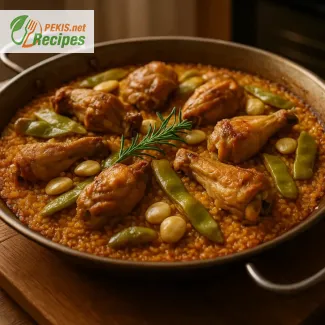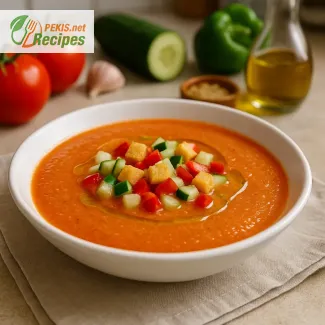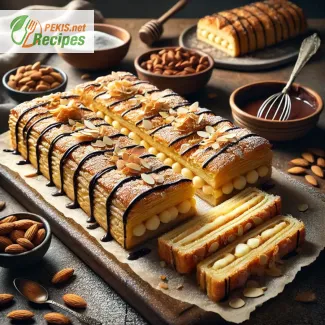
Discover the Culinary Heritage of Paella Valenciana
A deep dive into Spain’s most emblematic rice dish
Among Spain’s many regional delicacies, few dishes hold the cultural and culinary prestige of the Paella Valenciana. This vibrant saffron-infused rice dish is more than just a recipe—it's a symbol of Valencia’s culinary identity, a meal steeped in history, and a ritual that brings families together every Sunday. While countless variations exist worldwide, only one can claim authenticity: the original Valencian paella, rooted in the traditions of eastern Spain and prepared with ingredients that reflect the rural landscape of its birthplace.
The origin of Paella Valenciana
The word paella derives from the Old French paelle, which simply means "pan," but in the Valencian context, it refers to both the special wide, shallow pan and the dish itself. Paella Valenciana dates back to the mid-19th century, born in the Albufera region of Valencia, where rice cultivation thrived. Initially a meal for farmers and laborers, the dish was prepared outdoors over open fires using locally sourced ingredients: rabbit, chicken, green beans, and snails, occasionally enriched with duck or artichokes depending on the season.
Over time, the original recipe gained iconic status and a protected cultural designation in Spain. Unlike seafood paellas or modern fusion adaptations, the authentic Valencian version follows a strict canon of ingredients and techniques that have been passed down for generations.
What makes this version “authentic”?
Authenticity in Paella Valenciana lies in three essential elements: the ingredients, the technique, and the setting. The approved ingredients, as outlined by Valencian culinary institutions, include:
- Chicken and rabbit as the primary proteins
- Garrofó (large Valencian white beans) and ferradura (green flat beans)
- Sofrito made from grated tomatoes, olive oil, sweet paprika, and a pinch of saffron
- Bomba or Senia short-grain rice
- Water, salt, and rosemary (optional)
These components come together in perfect harmony through a specific cooking technique: building the sofrito base, searing the meats, incorporating the beans, and adding rice only after the flavors have melded. The most debated moment is the "socarrat"—the crisp, caramelized layer of rice at the bottom of the pan, prized as a mark of a perfectly executed paella.
Cultural significance and ritual of preparation
In Valencia, paella is not just food—it’s a weekend tradition, often prepared outdoors with firewood and shared among extended family and friends. This sense of communal cooking gives the dish its enduring emotional value. It’s typically served straight from the paella pan, placed at the center of the table, where each diner eats from their assigned radial section.
The ritual begins early in the morning, with one designated cook (often a patriarch or seasoned home chef) overseeing every step. The pacing of the preparation, the layering of flavor, and the gathering of loved ones are as integral to the experience as the dish itself. This context is key to understanding why true Paella Valenciana must be approached with respect for its origins.
Common misconceptions and mistakes
As paella spread across Spain and into international kitchens, its identity blurred. Modern recipes often swap traditional proteins for seafood, use chorizo, or add excessive spices—not typical in the original Valencian style. These versions, while delicious in their own right, are technically not Paella Valenciana.
One of the most common errors is stirring the rice after it’s added to the pan. In the traditional method, rice is distributed evenly and left undisturbed to absorb the broth and develop texture. Another mistake is using long-grain rice, which fails to capture the creamy-yet-separated texture that is a hallmark of the dish.
Selecting the right rice and pan
To achieve the proper consistency and flavor, Bomba rice is the most recommended. It absorbs three times its volume in liquid without becoming mushy. If unavailable, other short-grain varieties like Senia or Bahía are suitable alternatives.
The paella pan (also called a paellera) is vital—not only for even cooking but for the signature shape of the dish. Its shallow, wide design allows liquid to evaporate uniformly, resulting in evenly cooked rice and the elusive socarrat. Traditional versions are made of polished steel and must be cared for like cast iron to prevent rusting.
Firewood, gas or stovetop?
In Valencia, purists will insist that paella should be cooked over open flame, preferably orange tree wood, which adds aromatic depth to the dish. In urban kitchens, gas burners or specialized paella burners mimic this control over flame distribution. While stovetop cooking is possible, it often results in uneven heat unless the pan fits perfectly and the heat is well adjusted.
Ultimately, what matters most is respecting the timing and heat control. Once the rice is added, it should be cooked undisturbed for about 18 minutes—no stirring, no lid. As the broth reduces, the rice should cook evenly and develop that golden, crispy base.
Why Paella Valenciana remains relevant today
Despite evolving food trends, Paella Valenciana remains a timeless centerpiece of Spanish gastronomy. It connects modern cooks with centuries-old traditions, celebrates local agriculture, and emphasizes patience, technique, and togetherness over convenience.
From Valencian rice fields to backyard gatherings across the globe, this dish embodies authenticity, regional pride, and culinary craftsmanship. Its story continues to captivate food lovers who seek a deeper understanding of Spain’s culinary soul—one pan at a time.
1. Sear the meat:
Heat the olive oil in a wide paella pan over medium-high heat. Add chicken and rabbit pieces, seasoning lightly with salt. Sauté until all sides are well browned (about 15 minutes). This is essential for building deep flavor.
2. Add the vegetables:
Lower the heat slightly. Add flat green beans and lima beans. Sauté for another 5 minutes, stirring occasionally to coat everything in oil and juices.
3. Build the sofrito:
Push meat and vegetables to the edge of the pan. In the center, add grated tomato and sweet paprika. Sauté gently for 3–4 minutes until a thick base forms.
4. Infuse the broth:
Pour in the water and saffron. Stir gently, then increase the heat to bring the mixture to a boil. Let it simmer for about 10 minutes. This allows the flavors from the meat and sofrito to combine into a rich broth.
5. Adjust salt and add rice:
Taste the broth and adjust salt if needed. Sprinkle rice evenly across the surface. Stir once to level the ingredients. Do not stir again afterward.
6. Simmer without stirring:
Cook on medium-high heat for 10 minutes. Reduce to medium-low and continue cooking for another 8 minutes. Optionally add rosemary sprig during the last few minutes. Avoid covering the pan.
7. Form the socarrat (crust):
Raise the heat for the final 2 minutes to create a light crust at the bottom, known as socarrat. Listen for a light crackling sound.
8. Rest and serve:
Remove the pan from heat and let the paella rest uncovered for 5–10 minutes. Serve directly from the pan, traditionally in radial sections.
Elevating the Essence of Paella Valenciana at Home
Expert tips and modern twists for a refined traditional experience
Paella Valenciana is a time-honored dish steeped in cultural significance, yet even the most classic recipes benefit from thoughtful refinement. Whether you're preparing the dish for the first time or looking to bring it to the next level, small adjustments and modern considerations can enhance both flavor and nutritional value without compromising authenticity. Below are professional insights for improving this revered rice dish while remaining true to its Valencian roots.
Ingredient upgrades that intensify flavor
Using premium ingredients is the simplest and most effective way to elevate the flavor profile of Paella Valenciana. For instance, selecting organic, free-range chicken and rabbit will produce cleaner, more complex meat flavors. Likewise, choosing extra virgin olive oil over standard varieties introduces subtle fruity and peppery notes that enhance the overall richness of the sofrito base.
Another major enhancement is the quality of saffron. Many home cooks opt for pre-ground or imitation products, which often lack the aromatic depth of real saffron threads. Investing in high-grade Spanish saffron, gently toasted and steeped in hot broth, amplifies the dish’s color, aroma, and floral undertones.
Homemade chicken or vegetable broth can also replace water for a deeper, more layered base. While not traditional, this modification subtly enriches the rice and supports a more flavorful result without overshadowing the primary ingredients.
Adjusting vegetables for seasonal or local variations
While traditional garrofó and ferraura beans are hard to source outside Spain, excellent substitutes include butter beans, runner beans, or even fresh fava beans. These alternatives retain the integrity of the recipe while allowing home cooks to use locally grown produce, which contributes to freshness and sustainability.
Adding artichoke hearts or asparagus tips in spring, or wild mushrooms in autumn, can introduce seasonal variation while respecting the earthy tone of the dish. These vegetables lend a unique texture and umami element, making each rendition more distinct and refined.
Health-conscious adjustments without sacrificing authenticity
For those seeking a lighter dish, consider reducing the oil quantity slightly or using leaner meat cuts. While the searing process is essential, it can still be effective with 60 ml of olive oil instead of the traditional 80 ml, particularly when using a nonstick paella pan.
Substituting Bomba rice with brown short-grain rice offers a higher fiber content, although this will extend cooking time and slightly alter the texture. If going this route, soak the rice beforehand and increase the simmering time by at least 10 minutes. The payoff is a heart-healthier version that still delivers the desired socarrat crust.
Another useful switch is replacing meat entirely with plant-based proteins, such as seared tofu, tempeh, or even jackfruit for its fibrous, meaty texture. Paired with legumes and roasted vegetables, these plant-based adaptations appeal to vegetarian diets while offering a flavorful reinterpretation.
Avoiding common pitfalls in preparation
One of the most frequent mistakes is overcrowding the pan, which leads to uneven cooking and loss of the signature socarrat. Using the correct paella pan size—ideally 34 to 36 cm for four servings—ensures the rice cooks evenly in a single, undisturbed layer.
Another error is stirring the rice after it’s been added. This disrupts the starch release and prevents the formation of the caramelized base. Once rice enters the pan, it should be left untouched to allow the top layer to remain fluffy while the bottom crisps up.
Incorrect heat management is another culprit. Too high, and the liquid evaporates before the rice is fully cooked; too low, and the socarrat never forms. Maintaining a steady medium-high simmer, followed by a reduced flame in the second half of cooking, is essential for precision.
Enhancing aroma and presentation
For added aroma, a sprig of fresh rosemary introduced during the final five minutes of cooking can subtly elevate the dish’s herbal dimension. To preserve its freshness, it should be removed before serving. Another finishing touch is a drizzle of high-quality olive oil over the rice just before resting, which adds sheen and depth without altering the balance.
To present the paella in a way that honors its cultural tradition, always serve directly from the pan, allowing guests to enjoy their portion from their respective section. This not only respects custom but also highlights the communal essence of the dish.
Why homemade paella always wins
Home-prepared Paella Valenciana carries a depth of character that restaurant versions often lack. In a home setting, you have complete control over every element—from browning the meat and adjusting the seasoning to customizing the rice texture to your liking. The result is more than a dish; it’s a sensory journey shaped by your ingredients, hands, and hearth.
Moreover, cooking at home allows for authentic timing—a slower, deliberate process that lets flavors develop gradually. Unlike rushed commercial versions, homemade paella benefits from patient attention, which is rewarded in every bite.
Exploring non-traditional enhancements
For cooks who feel confident in the traditional method, there is room for gentle innovation. Incorporating a splash of dry white wine into the sofrito can add acidity and brightness, enhancing the tomato’s natural sweetness. A small amount of smoked paprika alongside the sweet version can deepen the flavor profile for those who prefer bolder dishes.
Another option is to top the finished dish with roasted red pepper strips, which provide both color contrast and a mild sweetness that balances the savory meat. Though not traditionally part of Paella Valenciana, such elements have been embraced in modern adaptations without offending purists.
Finally, for enhanced visual appeal and complexity, preserved lemon zest or a hint of orange peel can be added to the broth. These citrus notes contribute brightness and create a multi-dimensional experience on the palate.
Allergens present in the recipe:
- Legumes (lima beans – garrofó)
- Sulfites (possible in saffron and canned tomato if used)
- Gluten: This recipe is naturally gluten-free, assuming no cross-contamination.
Substitution tips to avoid allergens:
- For legume intolerance, omit garrofó and increase green beans.
- Use fresh, unprocessed saffron and tomato to avoid sulfites.
- Ensure all spice blends and meats are labeled gluten-free.
Vitamins and minerals per serving (approximate):
- Vitamin B6: 0.8 mg – Supports immune function and brain health
- Vitamin C: 14 mg – Promotes collagen production and antioxidant defense
- Iron: 3.2 mg – Contributes to oxygen transport and energy metabolism
- Magnesium: 65 mg – Supports nerve and muscle function
- Zinc: 2.5 mg – Aids wound healing and DNA synthesis
- Phosphorus: 340 mg – Essential for bone health and ATP production
- Potassium: 640 mg – Regulates fluid balance and blood pressure
- Niacin (B3): 11 mg – Helps convert food into energy
Antioxidants per serving (approximate):
- Lycopene (from tomato): 5 mg – May reduce oxidative stress and protect heart health
- Saffronal (from saffron): 0.3 mg – Has anti-inflammatory and neuroprotective effects
- Vitamin E (from olive oil): 2.2 mg – Supports cell membrane health and skin function
- Polyphenols (from olive oil and beans): 150 mg – Help lower inflammation and oxidative damage

